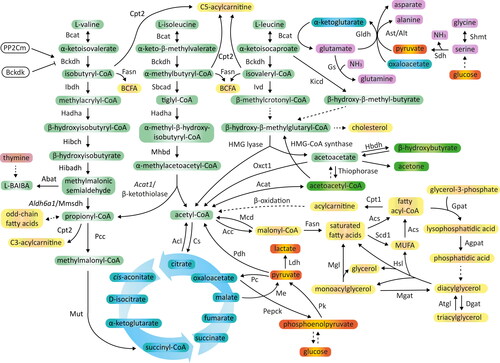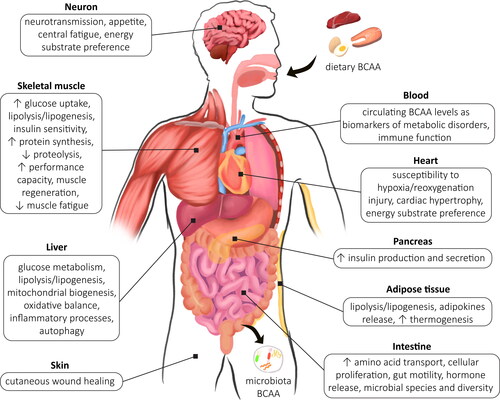Figures & data
Figure 1. Associations between glucose, fatty acid and amino acid metabolism. BCAA are metabolized within mitochondria through branched chain amino acid aminotransferase (Bcat) that catalyzes the transamination of BCAA by the transfer of amino group to α-ketoglutarate with a simultaneous generation of glutamate. Glutamate provides amino group to generate alanine from pyruvate or for condensation with ammonia to form glutamine. Branched chain keto acids (BCKA) are oxidatively decarboxylated by branched chain keto acid dehydrogenase (Bckdh). Finally, acyl-CoA metabolism diverges into separate pathways to CO2, and succinyl-CoA (valine, glucogenic) or acetyl-CoA (leucine, ketogenic), or acetyl-CoA and succinyl-CoA (isoleucine, glucogenic and ketogenic) production. Acetyl-CoA may also derive from lipolysis or glycolysis, and its conversion to CO2 and H2O depends on tricarboxylic acid cycle capacity. Among valine intermediates, β-hydroxyisobutyrate (3-HIB) and β-aminoisobutyric acid (BAIBA), can be secreted outside the cell and exert paracrine/endocrine functions. Abbreviations: Abat, 4-aminobutyrate aminotransferase; Acat, acetyl-CoA acetyltransferase; Acc, acetyl-CoA carboxylase; Acl, ATP citrate lyase; Acs, fatty acyl-CoA synthetase; Agpat, 1-acylglycerol-3-phosphate-O-acyltransferase; Aldh6a1/Mmsdh, aldehyde dehydrogenase 6 family member A1/methylmalonic semialdehyde dehydrogenase; Alt, alanine transaminase; Ast, aspartate transaminase; Atgl, adipose triglyceride lipase; BCFA, branched chain fatty acids; Bckdk, branched chain keto acid dehydrogenase kinase; Cpt1/2, carnitine palmitoyltransferase 1/2; Cs, citrate synthase; Dgat, diacylglycerol acyltransferase; Fasn, fatty acid synthase; Gldh, glutamate dehydrogenase; Gpat, glycerol-3-phosphate acyltransferase; Gs, glutamine synthetase; Hadha, hydroxyacyl-CoA dehydrogenase subunit α; Hbdh, 3-hydroxybutyrate dehydrogenase; Hibadh, 3-hydroxyisobutyric acid dehydrogenase; Hibch, 3-hydroxy-isobutyryl-CoA hydrolase; HMG lyase, 3-hydroxy-3-methylglutaryl-CoA lyase; Hsl, hormone-sensitive lipase; Ibdh, isobutyryl-CoA dehydrogenase; Ivd, isovaleryl-CoA dehydrogenase; Kicd, α-ketoisocaproate dioxygenase; Ldh, lactate dehydrogenase; Mcd, malonyl-CoA decarboxylase; Me, malic enzyme; Mgat, acyl CoA:monoacylglycerol acyltransferase; Mgl, monoacylglycerol lipase; Mhbd, α-methyl-β-hydroxybutyryl-CoA dehydrogenase; MUFA, monounsaturated fatty acids; Mut, methylmalonyl-CoA mutase; Oxct1, 3-oxoacid CoA transferase; Pc, pyruvate carboxylase; Pcc, propionyl-CoA carboxylase; Pdh, pyruvate dehydrogenase; Pepck, phosphoenolpyruvate carboxykinase; Pk, pyruvate kinase; PP2Cm, protein phosphatase 2 Cm; Sbcad, methylbutyryl CoA dehydrogenase; Scd1, stearoyl-CoA desaturase; Sdh, serine dehydratase; Shmt, serine hydroxymethyltransferase.

Figure 2. The network of intracellular signals transduction that modulate mammalian target of rapamycin (mTOR) activity. BCAA within the cell are sensed by leucyl tRNA synthetase and Sestrin, what precludes related GTP binding (Rag) complex activation that in turn stimulates GTP binding to Ras homolog enriched in brain (Rheb) protein and its activation, ultimately leading to mTORC1 upregulation. BCAA also suppress mTORC1 inhibitors, such as general control nonderepressible 2 (Gcn2) and 5’AMP-activated protein kinase (AMPK). The activity of mTORC1 is positively regulated by oxygen through protein regulated in DNA damage and development (Redd1), hormones or growth factors through phosphoinositide-3-kinase (PI3K)/Akt or mitogen-activated protein kinase kinase 1/2 (Mek1/2)/extracellular signal-regulated kinase 1/2 (Erk1/2) signaling cascades, which inactivate tuberous sclerosis complex 2 (TSC2) subunit of the TSC complex that stimulates Rheb activity. Upon activation, mTORC1 regulates various proteins, including unc-51 like autophagy activating kinase 1 (Ulk1), p70 S6 kinase (p70 S6K) and eukaryotic translation initiation factor 4E binding protein 1 (4E-BP1). Abbreviations: Deptor, DEP domain-containing mTOR-interacting protein; Gator, GTP-ase activating protein activity toward Rag; HIF-1α, hypoxia-inducible factor 1α; IRS1/2, insulin receptor substrate 1/2; mLST8, mammalian lethal with SEC13 protein 8; mSin1, mammalian stress-activated protein kinase-interacting 1; PDK1, 3-phosphoinositide-dependent kinase 1; Pras40, proline-rich Akt substrate of 40 kDa; Protor 1/2, protein observed with Rictor 1/2; Raptor, regulated associated protein of mTOR; Rictor, rapamycin insensitive companion of mTOR.

Table 1. Selected factors affecting BCAA metabolism in the blood, skeletal muscle, liver and adipose tissue.
Table 2. Metabolic characteristic of subjects undergone dietary BCAA deprivation or supplementation.
Table 3. Metabolic characteristic of subjects undergone genetic or pharmacological modulation of enzymes responsible for Bckdh phosphorylation/dephosphorylation.

